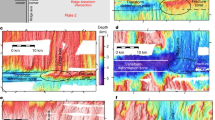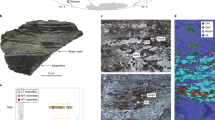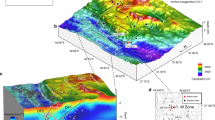Abstract
Transform faults accommodate the lateral motions between lithospheric plates, producing large earthquakes. Away from active transform boundaries, former oceanic transform faults also form the fracture zones that cover the ocean floor. However, the deep structure of these faults remains enigmatic. Here we present ultra-long offset seismic data from the Romanche transform fault in the equatorial Atlantic Ocean that indicates the presence of a low-velocity anomaly extending to ~60 km below sea level. We performed three-dimensional thermal modelling that suggests the anomaly is probably due to extensive serpentinization down to ~16 km, overlying a hydrated, shear mylonite zone down to 32 km. The water is considered to be sourced from seawater-derived fluids that infiltrate deep into the fault. Below 32 km is interpreted to be a low-temperature, water-induced melting zone that elevates the lithosphere–asthenosphere boundary, causing substantial thinning of the lithosphere at the transform fault. The presence of a thinned lithosphere at transform faults could explain observations of volcanism, thickened crust and intra-transform spreading centres at transform faults. It also suggests that migration and mixing of water-induced melt with the high-temperature melt may occur beneath the ridge axis.
This is a preview of subscription content, access via your institution
Access options
Access Nature and 54 other Nature Portfolio journals
Get Nature+, our best-value online-access subscription
$29.99 / 30 days
cancel any time
Subscribe to this journal
Receive 12 print issues and online access
$259.00 per year
only $21.58 per issue
Buy this article
- Purchase on Springer Link
- Instant access to full article PDF
Prices may be subject to local taxes which are calculated during checkout





Similar content being viewed by others
Data availability
The high-resolution bathymetry data, the multichannel seismic reflection data and the OBS data from OBS26 to OBS50 are available online (https://doi.pangaea.de/10.1594/PANGAEA.922331) under the condition of acknowledging Marjanović et al. 2020 (https://doi.org/10.1029/2020JB020275). The OBS data from OBS01 to OBS15 are available online (https://doi.pangaea.de/10.1594/PANGAEA.937195) under the condition of acknowledging Growe et al. 2021 (https://doi.org/10.1029/2021JB022456). The OBS data from OBS16 to OBS25 are available online (https://doi.org/10.1594/PANGAEA.946565).
Code availability
The tomography code used in this work is available on request from the corresponding author.
References
Wilson, J. T. A new class of faults and their bearing on continental drift. Nature 207, 343–347 (1965).
Bird, P. An updated digital model of plate boundaries. Geochem. Geophys. Geosyst. 4, 1027 (2003).
Bird, P., Kagan, Y. Y. & Jackson, D. D. in Plate Boundary Zones (eds Stein, S. & Freymueller, J. T.) 203–218 (AGU, 2002).
Roland, E., Lizarralde, D., McGuire, J. J. & Collins, J. A. Seismic velocity constraints on the material properties that control earthquake behavior at the Quebrada–Discovery–Gofar transform faults, East Pacific Rise. J. Geophys. Res. 117, B11102 (2012).
Gregory, E. P. M., Singh, S. C., Marjanović, M. & Wang, Z. Serpentinized peridotite versus thick mafic crust at the Romanche oceanic transform fault. Geology 49, 1132–1136 (2021).
GEBCO Bathymetric Compilation Group The GEBCO_2021 Grid: A Continuous Terrain Model of the Global Oceans and Land (BODC, 2021); https://doi.org/10.5285/c6612cbe-50b3-0cff-e053-6c86abc09f8f
DeMets, C., Gordon, R. G. & Argus, D. F. Geologically current plate motions. Geophys. J. Int. 181, 1–80 (2010).
Abercrombie, R. E. & Ekström, G. Earthquake slip on oceanic transform faults. Nature 410, 74–77 (2001).
Norris, R. J. & Toy, V. G. Continental transforms: a view from the Alpine Fault. J. Struct. Geol. 64, 3–31 (2014).
Müller, R. D., Sdrolias, M., Gaina, C. & Roest, W. R. Age, spreading rates, and spreading asymmetry of the world’s ocean crust. Geochem. Geophys. Geosyst. 9, Q04006 (2008).
Bonatti, E. et al. Steady-state creation of crust-free lithosphere at cold spots in mid-ocean ridges. Geology 29, 979–982 (2001).
Mehouachi, F. & Singh, S. C. Water-rich sublithospheric melt channel in the equatorial Atlantic Ocean. Nat. Geosci. 11, 65–69 (2018).
de Melo, G. W. S. et al. Uppermost mantle velocity beneath the Mid-Atlantic Ridge and transform faults in the equatorial Atlantic Ocean. Bull. Seismol. Soc. Am. 111, 1067–1079 (2021).
Van Avendonk, H. J. A., Shillington, D. J., Holbrook, W. S. & Hornbach, M. J. Inferring crustal structure in the Aleutian island arc from a sparse wide-angle seismic data set. Geochem. Geophys. Geosyst. 5, Q08008 (2004).
Grevemeyer, I., Rüpke, L. H., Morgan, J. P., Iyer, K. & Devey, C. W. Extensional tectonics and two-stage crustal accretion at oceanic transform faults. Nature 591, 402–407 (2021).
Prigent, C., Warren, J. M., Kohli, A. H. & Teyssier, C. Fracture-mediated deep seawater flow and mantle hydration on oceanic transform faults. Earth Planet. Sci. Lett. 532, 115988 (2020).
Kohli, A. H. & Warren, J. M. Evidence for a deep hydrologic cycle on oceanic transform faults. J. Geophys. Res. 125, e2019JB017751 (2020).
Kohli, A., Wolfson-Schwehr, M., Prigent, C. & Warren, J. M. Oceanic transform fault seismicity and slip mode influenced by seawater infiltration. Nat. Geosci. 14, 606–611 (2021).
McKenzie, D., Jackson, J. & Priestley, K. Thermal structure of oceanic and continental lithosphere. Earth Planet. Sci. Lett. 233, 337–349 (2005).
Guillot, S., Schwartz, S., Reynard, B., Agard, P. & Prigent, C. Tectonic significance of serpentinites. Tectonophysics 646, 1–19 (2015).
Hicks, S. P. et al. Back-propagating supershear rupture in the 2016 Mw 7.1 Romanche transform fault earthquake. Nat. Geosci. 13, 647–653 (2020).
Abers, G. A. & Hacker, B. R. A MATLAB toolbox and Excel workbook for calculating the densities, seismic wave speeds, and major element composition of minerals and rocks at pressure and temperature. Geochem. Geophys. Geosyst. 17, 616–624 (2016).
Yu, Z. et al. Semibrittle seismic deformation in high-temperature mantle mylonite shear zone along the Romanche transform fault. Sci. Adv. 7, eabf3388 (2021).
Lizarralde, D., Gaherty, J. B., Collins, J. A., Hirth, G. & Kim, S. D. Spreading-rate dependence of melt extraction at mid-ocean ridges from mantle seismic refraction data. Nature 432, 744–747 (2004).
Taylor, M. A. J. & Singh, S. C. Composition and microstructure of magma bodies from effective medium theory. Geophys. J. Int. 149, 15–21 (2002).
Katz, R. F., Spiegelman, M. & Langmuir, C. H. A new parameterization of hydrous mantle melting. Geochem. Geophys. Geosyst. 4, 1073 (2003).
Keller, T. & Katz, R. F. The role of volatiles in reactive melt transport in the asthenosphere. J. Petrol. 57, 1073–1108 (2016).
Wang, S., Constable, S., Rychert, C. A. & Harmon, N. A lithosphere–asthenosphere boundary and partial melt estimated using marine magnetotelluric data at the central Middle Atlantic Ridge. Geochem. Geophys. Geosyst. 21, e2020GC009177 (2020).
Rychert, C. A. et al. A dynamic lithosphere–asthenosphere boundary near the equatorial Mid-Atlantic Ridge. Earth Planet. Sci. Lett. 566, 116949 (2021).
Harmon, N. et al. Evolution of the oceanic lithosphere in the equatorial Atlantic from Rayleigh wave tomography, evidence for small-scale convection from the PI-LAB experiment. Geochem. Geophys. Geosyst. 21, e2020GC009174 (2020).
Marjanović, M. et al. Seismic crustal structure and morpho-tectonic features associated with the chain fracture one and their role in the evolution of the equatorial Atlantic region. J. Geophys. Res. 125, e2020JB020275 (2020).
Growe, K. et al. Seismic structure of the St Paul Fracture Zone and Late Cretaceous to mid Eocene oceanic crust in the equatorial Atlantic Ocean near 18° W. J. Geophys. Res. 126, e2021JB022456 (2021).
Fox, P. J. & Gallo, D. G. A tectonic model for ridge-transform-ridge plate boundaries: implications for the structure of oceanic lithosphere. Tectonophysics 104, 205–242 (1984).
Hékinian, R., Bideau, D., Hébert, R. & Niu, Y. Magmatism in the Garrett transform fault (East Pacific Rise near 13° 27ʹ S). J. Geophys. Res. 100, 10163–10185 (1995).
Maia, M. et al. Extreme mantle uplift and exhumation along a transpressive transform fault. Nat. Geosci. 9, 619–623 (2016).
Roland, E., Behn, M. D. & Hirth, G. Thermal-mechanical behavior of oceanic transform faults: implications for the spatial distribution of seismicity. Geochem. Geophys. Geosyst. 11, Q07001 (2010).
Behn, M. D., Boettcher, M. S. & Hirth, G. Thermal structure of oceanic transform faults. Geology 35, 307–310 (2007).
Le Voyer, M., Cottrell, E., Kelley, K. A., Brounce, M. & Hauri, E. H. The effect of primary versus secondary processes on the volatile content of MORB glasses: an example from the equatorial Mid-Atlantic Ridge (5° N–3° S). J. Geophys. Res. 120, 125–144 (2015).
Menard, H. W. & Atwater, T. Origin of fracture zone topography. Nature 222, 1037–1040 (1969).
ten Brink, U. S. et al. Seismic imaging of deep low-velocity zone beneath the Dead Sea basin and transform fault: implications for strain localization and crustal rigidity. Geophys. Res. Lett. 33, L24314 (2006).
Fuis, G. S. et al. in A Continental Plate Boundary: Tectonics at South Island, New Zealand (eds Okaya, D. et al.) 309–330 (AGU, 2007).
Fichtner, A. et al. The deep structure of the North Anatolian Fault Zone. Earth Planet. Sci. Lett. 373, 109–117 (2013).
Bécel, A. et al. Moho, crustal architecture and deep deformation under the North Marmara Trough, from the SEISMARMARA Leg 1 offshore–onshore reflection–refraction survey. Tectonophysics 467, 1–21 (2009).
Moser, T. J. Shortest path calculation of seismic rays. Geophysics 56, 59–67 (1991).
Korenaga, J. et al. Crustal structure of the southeast Greenland margin from joint refraction and reflection seismic tomography. J. Geophys. Res. 105, 21591–21614 (2000).
ASPECT: Advanced Solver for Problems in Earth’s Convection, User Manual. figshare https://doi.org/10.6084/M9.FIGSHARE.4865333 (2022).
Seyler, M. & Bonatti, E. Regional-scale melt-rock interaction in lherzolitic mantle in the Romanche Fracture Zone (Atlantic Ocean). Earth Planet. Sci. Lett. 146, 273–287 (1997).
Tartarotti, P., Susini, S., Nimis, P. & Ottolini, L. Melt migration in the upper mantle along the Romanche Fracture Zone (equatorial Atlantic). Lithos 63, 125–149 (2002).
Mookherjee, M. & Mainprice, D. Unusually large shear wave anisotropy for chlorite in subduction zone settings. Geophys. Res. Lett. 41, 1506–1513 (2014).
Goes, S., Govers, R. & Vacher, P. Shallow mantle temperatures under Europe from P and S wave tomography. J. Geophys. Res. 105, 11153–11169 (2000).
Clark, A. N., Lesher, C. E., Jacobsen, S. D. & Wang, Y. Anomalous density and elastic properties of basalt at high pressure: reevaluating of the effect of melt fraction on seismic velocity in the Earth’s crust and upper mantle. J. Geophys. Res. 121, 4232–4248 (2016).
Acknowledgements
We are grateful to the officers, crew and scientific technicians of the 2018 ILAB-SPARC cruise for their hard work. Discussions with D. Brunelli and B. Romanowicz were extremely useful. We thank S. P. Hicks, J. M. Warren and B. Urann for their useful comments and suggestions. Z.W. thanks I. Grevemeyer and H. Carton for their help during the progress of this project. The research leading to these results has received funding from the European Research Council under the European Union’s Seventh Framework Programme (FP7/2007–2013)/ERC Advance Grant agreement no. 339442_TransAtlanticILAB (SCS). We thank the Computational Infrastructure for Geodynamics (geodynamics.org), which is funded by the National Science Foundation under awards EAR-0949446 and EAR-1550901 for supporting the development of ASPECT. We are grateful to L. H. Rüpke for his help on thermal modelling using ASPECT and to G. Moguilny and M. Roharik for their help on the installation of ASPECT. The thermal modelling is performed on the S-CAPAD platform of IPGP, France. This is an IPGP contribution number 4267.
Author information
Authors and Affiliations
Contributions
Z.W. processed the OBS data, performed thermal modelling and wrote the paper. S.C.S. developed the project, led the data acquisition, supervised the data processing and interpretation and wrote the paper. C.P. participated in the calculations and interpretation. E.P.M.G. and M.M. participated in the data acquisition and data processing. All authors discussed results and contributed to the article.
Corresponding author
Ethics declarations
Competing interests
The authors declare no competing interests.
Peer review
Peer review information
Nature Geoscience thanks Ross Parnell-Turner and the other, anonymous, reviewer(s) for their contribution to the peer review of this work. Primary Handling Editors: Louise Hawkins, Simon Harold and Stefan Lachowycz, in collaboration with the Nature Geoscience team.
Additional information
Publisher’s note Springer Nature remains neutral with regard to jurisdictional claims in published maps and institutional affiliations.
Extended data
Extended Data Fig. 1 OBS data at intermediate offsets and comparisons of picked and modelled travel times.
a, Bathymetry map showing the location of the Romanche TF, the seismic profile (black line) and the locations of OBSs (red stars). b,c, Seismic sections and the picked Pn travel times, marked in red. OBS29 (b), OBS16 (c). The seismic data are plotted at travel time reduced at a reduction velocity of 8.0 km/s. The effect of bathymetry variations is removed by subtracting the propagating time in water, assuming a water velocity of 1.5 km/s. The cyan ellipses on the seismic plots indicate the location of the Romanche transform zone. A travel time delay and amplitude weakening are observed on the seismic sections where the seismic waves enter the Earth within the Romanche transform zone. d,e, Comparisons of picked travel times (in red) and modelled travel times (in blue). OBS29 (d), OBS16 (e). The red error bars indicate the picking uncertainty. The zero offset corresponds to the OBS location.
Extended Data Fig. 2 Final tomographic model and the density of ray coverage.
a, Final tomographic model and b, the density of ray coverage. The black contours and the numbers indicate the velocity in km/s. The maximum ray sampling depth is ~60 km in the final inverted model. The grey circles represent the locations of OBSs. The inverted triangles show the location of the Romanche transform zone. The portion of the tomographic velocity model within 200–650 km profile distance range is shown in Fig. 3a. The zero distance starts from the south along the profile shown in Fig. 1.
Extended Data Fig. 3 Vertical smearing tests.
a–f, Smearing effect tests for a low-velocity anomaly (LVA) in the mantle extending down to 30 km (a and b), 40 km (c and d) or 50 km (e and f) depth beneath the Romanche TF. The width of the inserted LVA is 30 km in a, c and e, and 50 km in b, d and f. The black dashed lines represent the side boundaries of the inserted LVAs, and the red solid lines show the base of the LVAs. The numbers labelled on the contours represent velocity reduction in percentage after the inversion.
Extended Data Fig. 4 Optimised synthetic mantle velocity model.
a, Optimised synthetic mantle velocity structure including a low-velocity anomaly with the final estimated width and velocity (Extended Data Table 2). b, Tomographic result of the travel times modelled using the synthetic model in a. The inverted black triangles indicate the location of the Romanche transform valley. The black contours and the numbers indicate the velocity in km/s.
Extended Data Fig. 5 Mantle serpentinization estimate.
The mantle P-wave velocity as a function of the degree of mantle serpentinization. The grey zone represents the estimated mantle velocity within the Romanche transform zone above 16 km depth. The squares and dots represent the mantle velocities at the Moho and at 16 km depth, respectively. The bars indicate the uncertainty bounds. P, pressure. T, temperature.
Extended Data Fig. 6 Mantle hydration and mylonitization estimates.
a–d, The mantle P-wave velocity (black line) as a function of degree of hydration (a,b) or degree of mylonitization (c,d); for 16 km depth (a,c) and for 32 km depth (b,d). The thick red solid lines indicate the velocities at 16 km and 32 km and thin red lines are uncertainty bounds. The red dashed lines are bounds in %.
Extended Data Fig. 7 Melt fraction estimation.
P-wave velocity variation as a function of melt fraction at 32 km (a) and 60 km (b) depths below sea level. The aspect ratio of melt r = 50 is used in the estimations. The thick red solid lines indicate the velocity at each depth and the thin red lines are uncertainty bounds. The thick red dashed lines indicate the estimated melt fractions, and the thin dashed lines are uncertainty bounds. r = 1 for spherical melt inclusions.
Extended Data Fig. 8 Solidus of mantle.
a,b, Solidus of mantle with different bulk of water at 32 km depth (a) and 60 km depth (b).
Supplementary information
Supplementary Information
Supplementary Figs. 1–11 and Tables 1 and 2.
Rights and permissions
Springer Nature or its licensor holds exclusive rights to this article under a publishing agreement with the author(s) or other rightsholder(s); author self-archiving of the accepted manuscript version of this article is solely governed by the terms of such publishing agreement and applicable law.
About this article
Cite this article
Wang, Z., Singh, S.C., Prigent, C. et al. Deep hydration and lithospheric thinning at oceanic transform plate boundaries. Nat. Geosci. 15, 741–746 (2022). https://doi.org/10.1038/s41561-022-01003-3
Received:
Accepted:
Published:
Issue Date:
DOI: https://doi.org/10.1038/s41561-022-01003-3
This article is cited by
-
Seismic evidence for uniform crustal accretion along slow-spreading ridges in the equatorial Atlantic Ocean
Nature Communications (2022)



